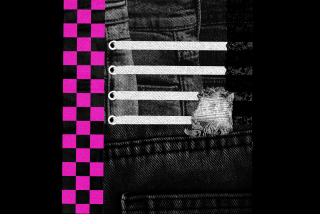The skinhead as more than hate monger
“THE skinheads have never had their story told properly in my mind,” said writer and director Shane Meadows. “True skinheads.”
Looking to avoid the kind of straight-up bully boys familiar to movie-goers from such films as “Made in Britain,” “Romper Stomper” and “American History X,” Meadows wanted his new feature film, “This Is England,” to serve as a reminder that skinhead culture began as more than just an outlet for racist hate.
In many ways an offshoot of ‘60s mod, original skinhead culture fused black music, notably Jamaican ska and American R&B;, with a spiffed-up take on British working-class style. As portrayed in “This Is England,” the seeping, malignant influence of far right-wing politics was something else altogether.
“We didn’t want to create the kind of skinhead you’d seen before,” said actor Stephen Graham, who plays a menacing but vulnerable skinhead nicknamed Combo. “The challenge was we wanted people to feel sorry for him in a way, to be horrified by his actions but also have some sympathy for the character. We wanted to show a three-dimensional skinhead.”
Set during the summer of 1983, the film -- which opens Friday in New York and Aug. 3 in Los Angeles -- follows 12-year-old Shaun, a boy whose father has recently been killed fighting in the Falklands. He falls in with a group of rambunctious, racially integrated, essentially apolitical skinheads, and the attendant swirl of getting just the right shoes, clothes and haircut. When Combo, an older member of the gang, returns from a stint in prison under the sway of the extremist politics of the National Front party, Shaun suddenly finds himself heading down a road of hate and violence at odds with the unspoken unifying ideals of his other new friends.
A skinhead himself for a time as a young teen -- Meadows has a crude cross tattooed on one finger like the one Shaun is shown getting in the film -- the director wanted to make something that was both an autobiographical coming-of-age tale and an examination of subcultures and how they develop.
But one of the deeper dimensions of the film’s story came wholly as a surprise to Meadows.
Worried he wouldn’t get cast if Meadows knew he was half black, Graham kept his background a secret until just before shooting when he confided his heritage to actor Andrew Shim as a way of apologizing for the things he would have to say and do during production.
Shim, who plays a character called Milky, knew Meadows would take to the idea, and encouraged Graham to tell him. Though it is never mentioned in the film, the three decided that Combo’s anger could be fueled in part by confusion over his own mixed-race heritage. To add to their blending of life and art, the night before shooting a confrontational scene, Shim took Graham and Meadows to his grandmother’s house for a traditional Jamaican dinner.
The character of Shaun is in nearly every scene and the story’s arc is largely from his perspective, which made casting the right actor essential. Meadows knew he had found his lead nearly from the moment he laid eyes on Thomas “Tommo” Turgoose, then 13.
“We’d probably seen 200 kids before we met Thomas,” said Meadows. “We went out street casting -- we realized this kid was not going to be found in a drama workshop or acting school. Des Hamilton, the casting director, found Tommo and, first thing, [Tommo] demanded five pounds to turn up for an audition. All the other kids were desperate to be in a film and he thought already that he wasn’t going to get the part, so all he was trying to do was get some money for sweets.”
A bit of deception
WORKING with Turgoose could prove taxing. Not being a professional, the boy’s attention span wasn’t always equal to the rigors of shooting a feature film. For added realism in a climactic scene in which Shaun reacts to Combo’s severe beating of Milky, Shim and Graham resorted to a little white lie.
“For some reason that was one of Tommo’s days when he wasn’t concentrating very much,” recalled Shim. “So I told him I was really nervous about the scene because it’s not easy being beat up on camera. And he asked, ‘Is he really going to beat you up?’ And I said, ‘Yeah.’
“So we started building it up, and he started getting worried for me because he believed I was actually going to be beaten up. So when he’s crying, I think he was actually crying for me. I felt a bit bad afterward but it seemed to work, to be honest.”
According to Meadows, since its release in the U.K. in April, “This Is England” has out-grossed his four previous features combined. But even more pleasing to the director is the way in which the film has spurred articles and commentary beyond the entertainment pages, becoming a part of the broader cultural conversation. Meadows noted that a newspaper recently used a picture of Turgoose to illustrate a story on school reform.
Despite its period trappings and style markers, “This Is England” is meant as a film very much for the here and now, not as empty nostalgia. “The film is called ‘This Is England,’ ” Meadows noted. “We never chose the title ‘This Was England.’ ”
More to Read
Only good movies
Get the Indie Focus newsletter, Mark Olsen's weekly guide to the world of cinema.
You may occasionally receive promotional content from the Los Angeles Times.











